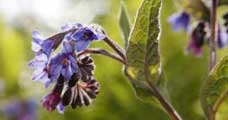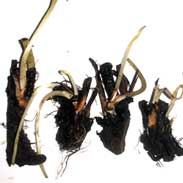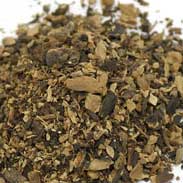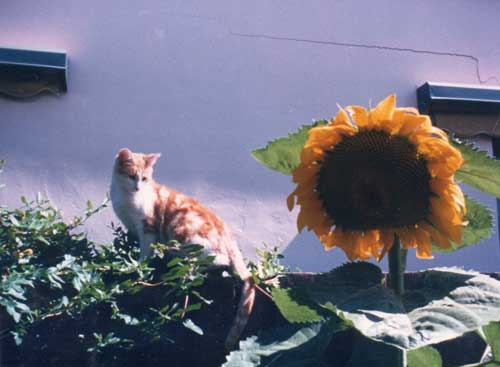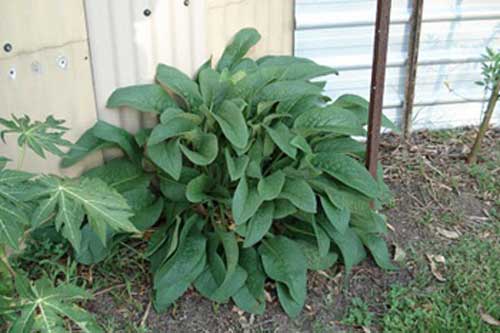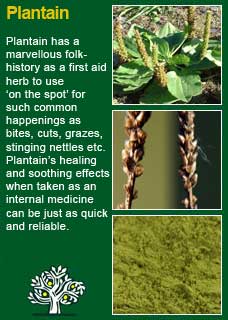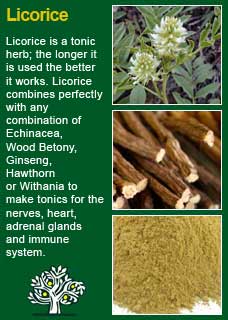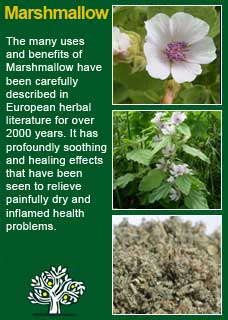
|
|
||||
| Our Pages ABOUT CONSTITUTIONAL MEDICINE
|
In herbal medicine, we have used the roots and leaves of Comfrey, a fast-growing, long-lived plant that forms a ‘rosette’ of lance shaped leaves (up to 30cms long) that put up a tall flowering stem up to 1.5 meters high. Comfrey leaves have many medicinal properties; they are rough textured and covered in short stiff hairs. The roots are also very famous in herbal medicine, they are short, thick, many-branched and they have a black surface with a white, chewy, mildly sweet interior.
As some of its other names suggest, (knitbone, boneset) Comfrey has been prized since ancient times for its ability to help heal broken bones and damaged tissues. In modern times, it has been discovered that this is at least in part due to a substance in Comfrey called ‘allantoin’ that is able to accelerate cellular 'mitosis', meaning it speeds the process of new tissue growth. Comfrey has been historically used for all manner of injuries and accidents including but not limited to broken bones. It has an equally strong reputation for helping with external wounds that are poorly healing. Comfrey has been used for ulceration anywhere along the gastrointestinal tract, for bleeding from the stomach, throat, bowel, bladder and lungs. Comfrey used to be used extensively for tuberculosis and irritating dry lung complaints in general. King's Dispensatory writes 'Comfrey root is very useful in diarrhoea, dysentery, bronchial irritation, coughs, hemoptysis, other pulmonary affections, leucorrhoea, and female debility. It is also of value in passive hemorrhages from the bowels, kidneys, or womb. Comfrey is demulcent and slightly astringent. With other mucilaginous agents it exerts an influence on mucous tissues, hence the cure, by their internal use, of many pulmonary and other affections in which these tissues have been chiefly implicated'
One night in the mid-1980s, when I was early into my herbal studies, our house cat in Melbourne crossed the road and was hit by a car. We do not know how long she must have lain on the side of the road but when we finally found her she was not in any obvious pain but she looked absolutely awful and could not move her back legs. My flat mate and I took her to the emergency vet in Carlton where they told us that her spine was broken and that the right thing to do would be to put her to sleep. We decided that as she was not in acute pain that we should take her home for a day or two for everyone to say goodbye and then come back for them to do the deed. It just so happened that I had been reading about Comfrey at that time and as we went home I had what I can only describe as a compulsion to use some for our cat. I did have a small amount of the extract with me (I started using and experimenting with herbs practically from day one that I started learning about them) and, unusually for a cat, she seemed quite happy to take a few drops straight in her mouth. I suppose I must have really believed it was going to do her some good because I managed to convince the others in the house to leave her in my care for more than just the next day. Over the coming week a little miracle happened that, to this day, my rational brain finds hard to fathom. She rested and slept nearly the entire time but she also slowly began moving herself more and more until finally, at the end of a week, she got out of her basket and walked again. Within a month she was running, no limp, no incontinence, and no sign of having had her spine broken in two... They did an x-ray of her spine before they told us it was broken and that she therefore had no hope, if I could go back in time I would have taken a hat around my flat-mates to get the money to go back for a second x-ray. What an amazing proof for Comfrey that would have been! I wish I had taken her back for that follow up but when you are a student it is hard enough to pay the rent let alone find the money for a vet bill. It was an extraordinary introduction to me to Comfrey and just how powerful healing herbs can truly be. In later years as I became aware of the controversy and cautions around Comfrey I greatly reduced my use of it but I have never forgotten it and never will.
Here she is, my Melbourne cat, alive and well after her accident! External applications of Comfrey leaf and root are no problem in terms of potential toxicity and they work beautifully. I use a great deal of Comfrey leaf and root in compresses and creams for a person who has wounds or sores that are not healing well. However, the internal use of Comfrey has to be undertaken with great sensitivity and care or not at all. Comfrey has real potential to harm the liver. Comfrey has performed further little miracles in my practice to this day but I use it rarely and extremely carefully (doing frequent blood tests in my clinic whilst the patient is using it to look for characteristic hallmarks of liver stress). I would counsel anyone who is not trained in herbal medicine or who has undergone rigorous study into the scientific literature on Comfrey simply to simply not self-medicate with this plant internally. My thoughts on when the internal use is justified are well-represented here by the great English herbalist Thomas Bartram. He writes 'It would appear that the use of the root of Symphytum officinale may be justified in the treatment of severe bone diseases for which it has achieved a measure of success in the past, such as rickets, Paget's disease, fractured bones etc. its benefits outweighing risks. Few other medicinal plants replenish wasted bone cells with the speed of Comfrey' Comfrey combines extremely well with Calendula and Plantain to help healing and for many people it will be much wiser to use either of those great herbs for any internal 'wounds' and then only add the Comfrey if the treatment is to be used externally. Comfrey can also work particularly well with a little Licorice or Marshmallow root for cracks, cuts and dry skin problems that are not healing well.
For some years now, against this proven and safe way of herbalism, there has been a rising tide of excessive caution and scare-mongering in many parts of the world. The same authorities that, not so long ago, decried herbal medicines as ineffectual, have now taken up a different adversarial position; that they are dangerous substances that should only be prescribed by Doctors, who of course have zero training in them. Unfortunately, the same unnecessary fear and worry has crept into many natural health websites and popular publications on herbs. Herbs that we have safely used for thousands of years, that have no reports of adverse reactions in the medical literature despite widespread use by millions of people, are suddenly described as contraindicated because of something that should have been seen as completely unimportant, or at the utmost a merely theoretical concern, such as a laboratory study on one of the herb's constituents to use an all too common example. I wonder sometimes if the writers of such articles feel that the herb will be more deserving of respect if it is thought to be a little bit dangerous, in other words more like a drug than something that has simply come out of the earth and been used by ordinary people for generations beyond count. There is just so much misinformation about herbal medicine on the internet now. Ludicrous claims and cautions abound in equal measure; it seems like one group are trying to make money out of the public whilst the other are busily trying to scare them off. I have to believe that the kind of reader who takes the time to read pages on herbs that are as extensive as this one is much less likely to be swayed by marketers or misinformers. I hope that you will keep your wits about you if you get conflicting opinions from people who have never really got to know these herbs, who have never worked with them, or learned how to use them safely and effectively. I want to remind you that the reason that herbs can never be patented and owned by any individual or corporation is because they are, and always will be, the People's medicine. They belong to all of us and it is my great hope in sharing this work that you will learn how to use them wisely for yourself, and the people you care for. Be safe, but do not be afraid.
Much of the information here about the traditional uses of Comfrey is consistent with the model of thinking whereby one may treat problem A with plant B. There is value in this approach, especially in how it helps us pass on useful knowledge to one another, but it falls short in one vital area; and that is that people are not all cut from the same cloth! Something that works brilliantly for one person may do less for another -- why is this? Part of the reason is that people vary in their constitutions as to whether they are either hotter or cooler and, at the same time, either dryer or damper. This useful and rather fascinating subject is introduced further here Another big part of using the right herb when it is most needed comes from understanding the need to treat what is going wrong for the person that had led up to their getting a health condition. In this light, Comfrey can particularly offer its benefits when a nourishing action is needed in the 'cycle of healing', more about this here
Please understand that I cannot advise you, including on products or dosage, without seeing you in person in my clinic but for ideas
on how you might find a good herbalist in your area read here |
|
|
© 2011 R.J.Whelan Ltd
